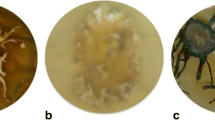Abstract
Puccinia graminis (Uredinales) is an economically important and common host-alternating rust species on Berberidaceae/Poaceae (subfamilies Pooideae and Panicoideae) that has been spread globally by human activities from an unknown center of origin. To evaluate the taxonomic implications, phylogenetic relationships, and distribution/spread of this complex species, we sequenced and cladistically analyzed the ITS1, 5.8S, and ITS2 regions from herbarium specimens on various host plants from Iran (17), Europe (1), and North America (4). The ITS region plus the 5.8S gene ranged from 686 to 701 bp, including the flanking partial sequences of the 18S and 28S rDNA. Our phylogenetic analysis included 54 bp of the 18S sequence, the entire ITS1 + 5.8S + ITS2, and 58 bp of the 28S sequence. A second analysis used only the last 42 bp of ITS1, and all the 5.8S and ITS2, to incorporate data from additional sequences downloaded from GenBank. In addition to variation in sequence length, there was variation in sequence content. The analysis does not support classical morphology-based taxonomic concepts of the P. graminis complex. Also, host range, host taxonomy, and geographic origin provide minor information on taxonomic relationships. Puccinia graminis is most probably monophyletic. Coevolutionary aspects can hardly be discussed because of lack of sequence data from alternate host specimens. The occurrence of unrelated fungal taxa on the same host species suggests that, besides coevolution with the host, host jumps and hybridization may have played an important role in the evolution of P. graminis. From rDNA data we conclude that the pathogen was introduced to North America at least twice independently. For a new taxonomic concept, we think the complex has to be split into at least two species. New morphological features and further features other than sequence data, however, must be checked for taxonomic value first and, if necessary, be considered.
Similar content being viewed by others
References
M Abbasi GA Hedjaroude D Ershad F Termeh (2002) ArticleTitleOn the taxonomy of Puccinia graminis Pers. and some remarks on the ecology of the rust in Iran Iran J Plant Pathol 38 9–42
Y Anikster I Wahl (1979) ArticleTitleCoevolution of the rust fungi on Gramineae and Liliaceae and their hosts Annu Rev Phytopathol 17 367–403 Occurrence Handle10.1146/annurev.py.17.090179.002055
JJ Burdon DR Marshall (1981) ArticleTitleIsozyme variation between species and formae speciales of the genus Puccinia Can J Bot 59 2628–2634
GB Cummins (1971) The rust fungi of cereals, grasses and bamboos Springer Berlin, Heidelberg, New York
E Gäumann (1959) ArticleTitleDie Rostpilze Mitteleuropas mit besonderer Berücksichtigung der Schweiz Beitr Kryptogamenflora Schweiz 12 1–1407
SB Goodwin VL Zismann (2001) ArticleTitlePhylogenetic analyses of the ITS region of ribosomal DNA reveal that Septoria passerinii from barley is closely related to the wheat pathogen Mycosphaerella graminicola Mycologia 93 934–946
SB Goodwin LD Dunkle VL Zismann (2001) ArticleTitlePhylogenetic analysis of Cercospora and Mycosphaerella based on the internal transcribed spacer region of ribosomal DNA Phytopathology 91 648–658
GJ Green (1971) ArticleTitleHybridization between Puccinia graminis tritici and Puccinia graminis secalis and its evolutionary implications Can J Bot 49 2089–2095
T Johnson (1949) ArticleTitleIntervarietal crosses in Puccinia graminis Can J Res C 27 45–65
T Johnson M Newton AM Brown (1932) ArticleTitleHybridization of Puccinia graminis tritici with Puccinia graminis secalis and Puccinia graminis agrostidis Sci Agric 13 141–153
M Kimura (1980) ArticleTitleA simple method for estimating evolutionary rates of base substitutions through comparative studies of nucleotide sequences J Mol Evol 16 111–120 Occurrence Handle7463489
EE Leppik (1961) ArticleTitleSome viewpoints on the phylogeny of rust fungi. IV. Stem rust genealogy Mycologia 53 378–405
EE Leppik (1970) ArticleTitleGene centers of plants as sources of disease resistance Annu Rev Phytopathol 8 323–344 Occurrence Handle10.1146/annurev.py.08.090170.001543
McAlpine D (1906) The rusts of Australia. Their structure, nature and classification. Robert S. Brain, p 349
G Perrière M Gouy (1996) ArticleTitleWWW-Query: an online retrieval system for biological sequence banks Biochimie (Paris) 78 364–369
N Saitou M Nei (1987) ArticleTitleThe neighbor-joining method: a new method for reconstructing phylogenetic trees Mol Biol Evol 4 406–425 Occurrence Handle3447015
DBO Savile Z Urban (1982) ArticleTitleEvolution and ecology of Puccinia graminis Preslia 54 97–104
M Scholler (1998) ArticleTitleObligate phytoparasitic fungi as plant taxonomists: an overview under special consideration of the rust fungus P. lagenophorae J Plant Dis Protect 105 239–245
CA Swertz (1994) ArticleTitleMorphology of germlings of urediniospores and its value for the identification and classification of grass rust fungi Stud Mycol 36 1–152
J Taylor E Swann (1994) Dried samples: soft tissues, DNA from herbarium specimens B Herrmann S Hummel (Eds) Ancient DNA Springer New York 166–181
JD Thompson TJ Gibson F Plewniak F Jeanmougin DG Higgins (1997) ArticleTitleThe CLUSTAL_X windows interface: flexible strategies for multiple sequence alignment aided by quality analysis tools Nucl Acids Res 25 4876–4882 Occurrence Handle10.1093/nar/25.24.4876 Occurrence Handle9396791
Z Urban (1967) ArticleTitleThe taxonomy of some European graminicolous rusts Česká Mykol 21 12–16
Z Urban J Markova (1983) ArticleTitleOn the taxonomy and ecology of Puccinia graminis Cereal Rusts Bull 11 12–16
Z Urban J Markova (1984) ArticleTitleEcology and evolution of Puccinia graminis Pers Ceska Mykol 38 65–95
NI Vavilov (1992) Origin and geography of cultivated plants University Press Cambridge, England
TJ White T Bruns S Lee J Taylor (1990) Amplification and direct sequencing of fungal ribosomal DNA for phylogenetics MA Innis DH Gelfand JJ Sninsky TJ White (Eds) PCR protocols: a guide to the methods and applications Academic San Diego
PJ Zambino LJ Szabo (1993) ArticleTitlePhylogenetic relationships of selected cereal and grass rusts based on rDNA sequence analysis Mycologia 85 401–414
P Zwetko HW Pfeifhofer (1991) ArticleTitleCarotinuntersuchungen an Rostpilzsporen. Bedeutung für die Physiologie und Taxonomie Nova Hedwegia 52 251–266
Author information
Authors and Affiliations
Corresponding author
About this article
Cite this article
Abbasi, M., Goodwin, S. & Scholler, M. Taxonomy, phylogeny, and distribution of Puccinia graminis, the black stem rust: new insights based on rDNA sequence data. Mycoscience 46, 241–247 (2005). https://doi.org/10.1007/s10267-005-0244-x
Received:
Accepted:
Issue Date:
DOI: https://doi.org/10.1007/s10267-005-0244-x




